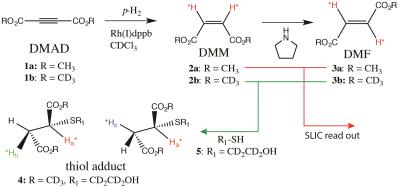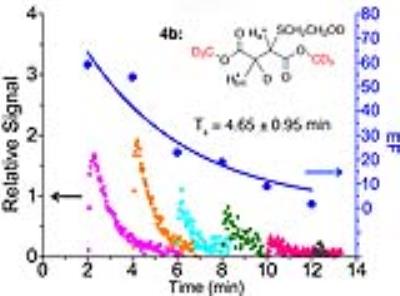0164
Hyperpolarized Nuclear Spin Singlets. Opportunities for Polarization Storage. What Limits Their Lifetimes?1New York University, New York, NY, United States, 2Institute of Organic Chemistry and Biochemistry, Czech Academy of Sciences, Prague, Czech Republic
Synopsis
Hyperpolarization techniques have offered the prospect of higher sensitivity and fast imaging, as well as tracking of metabolism in real-time. Nuclear spin singlet states allow the storage of polarization for an extended period of time. Here we present results on the limiting factors for nuclear singlet state lifetimes, and methods by which they can be determined in organic molecules, which is important for designing appropriate contrast agents, or hyperpolarization techniques that track metabolites.
Introduction
Hyperpolarization techniques have offered the prospect of higher sensitivity and fast imaging, as well as tracking of metabolism in real-time. The recent focus on nuclear spin singlet states and their creation and conversion to triplet states has led to the ability to store polarization for an extended period of time. Singlet lifetimes of more than 1 hour have been detected for low-gamma nuclei, and ~5 min for protons. This extended time opens the opportunity for new applications that take advantage of this longer storage time. Here we investigate the nuclear singlet state lifetimes and the factors that contribute to its limit. We also present a chemical desymmetrization readout mechanism1 of singlet states which are prepolarized using parahydrogen induced polarization (PHIP). One molecule under study (dimethyl fumarate) is also a drug molecule for multiple sclerosis, and hence its hyperpolarization is of relevance as well. This methodology and specific reactions could also be used to monitor enzyme reactions.Theoretical background
We present results on the intramolecular dipolar coupling, the chemical shift anisotropy (both the symmetric and the antisymmetric one), and the intermolecular dipolar coupling relaxation mechanisms (to other nuclear spins, or electrons spins such as those from dissolved oxygen), and the influence of symmetry on the lifetimes. Dimethyl fumarate (DMF), a molecule in which a singlet can be formed in a highly symmetric state (inversion center), provides a means for testing fundamental nuclear singlet lifetime limits. When its methyl groups are deuterated, the vinylene protons form essentially an A2 spin system, and dipolar couplings are excluded as a relaxation mechanism. Likewise, because of the inversion center, the chemical shift anisotropy mechanism is excluded. As a result, one would expect these nuclear spin singlets to be particularly long-lived.Experimental
The pulse sequence and injection scheme are shown in Fig. 1 with the desymmetrization reaction shown in Fig. 2. The experiments are performed for the vinylene protons at a field of 11.7 T. The vinylene protons are hyperpolarized using PHIP. Results are shown in Fig. 3. The experiments show that it is difficult to exceed a lifetime of ~6 min with the DMF molecule. This time is on par with the lifetime for dimethyl maleate (DMM), which does not have an inversion center, and is prone to CSA relaxation. Although a sizeable contribution from dissolved oxygen can be found, experiments with removed oxygen show similar results.2,3 Therefore, it appears likely that another relaxation mechanism must be due to this hard limit.4,5 In previous work it has been suggested that a mechanism based on internal configurational motions could be responsible for this effect.4,5 The mechanism has been termed spin-internal motion mechanism, but has yet to be formalized or documented experimentally.Conclusions
The study of the lifetime limiting factors and efficient long-term storage of hyperpolarization could provide important opportunities for imaging. We also present a hyperpolarization route for DMF based on parahydrogen induced polarization (PHIP) through DMM, with subsequent isomerization. Reading out the signal encoded in singlet states of molecules with high symmetry is non-trivial and we provide an example of a well-controlled chemical desymmetrization reaction which reveals the otherwise silent signal. The reaction with thiols forms a prototype for enzyme-induced isomerization, and this mechanism could therefore be used for monitoring enzyme activity. DMF is important, because it is a drug molecule for multiple sclerosis and its metabolism and kinetic conversion are little known. Its derivatives are likewise considered as drugs and their preparation in hyper polarized form would be important as well.Acknowledgements
This work was supported by US National Science Foundation(NSF) grants CHE-1412568 (J.C.) and CHE-0957586 (A.J.), as well as the Margaret and Herman Sokol Doctoral Fellowship 2014–2015 (Y.Z.).References
1. Zhang, Y., Soon, P. C., Jerschow, A., Canary, J. W. Long-lived (1)H nuclear spin singlet in dimethyl maleate revealed by addition of thiols, Angew Chem Int Ed Engl, 2014, 53:3396.
2. Zhang, Y., Duan, X., Soon, P. C., Sychrovsky, V., Canary, J. W., Jerschow, A. Limits in Proton Nuclear Singlet-State Lifetimes Measured with para-Hydrogen-Induced Polarization, Chemphyschem, 2016, 17: 2967.
3. Zhang, Y., Basu, K., Canary, J. W., Jerschow, A. Singlet lifetime measurements in an all-proton chemically equivalent spin system by hyperpolarization and weak spin lock transfers, Phys Chem Chem Phys, 2016, 18: 4221.
4. Stevanato, G., Hill-Cousins, J. T., Håkansson, P., Roy, S. S., Brown, L. J., Brown, R. C., Pileio, G., Levitt, M. H. A Nuclear Singlet Lifetime of More than One Hour in Room-Temperature Solution, Angew Chem Intl Ed, 2015, 54: 3740.
5. Stevanato, G., Roy, S. S., Hill-Cousins, J., Kuprov, I., Brown, L. J., Brown, R. C., Pileio, G., Levitt, M. H. Long-lived nuclear spin states far from magnetic equivalence, Phys Chem Chem Phys, 2015, 17: 5913.
Figures


